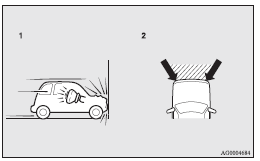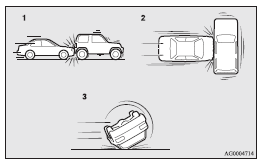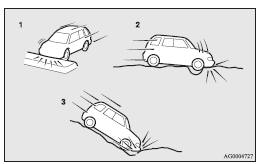Deployment of front airbags and driver's knee airbag (SRS) - airbag - Seat and seat belts - Mitsubishi ASX Owner's Manual - Mitsubishi ASX" border="0" width="100" align=right>
(SRS) - airbag - Seat and seat belts - Mitsubishi ASX Owner's Manual - Mitsubishi ASX" border="0" width="100" align=right>
The front airbags and driver’s knee airbag ARE DESIGNED TO DEPLOY when…
The front airbags and driver’s knee airbag are designed to deploy when the vehicle suffers a moderate to severe frontal impact. Examples of some typical conditions are shown in the illustration.

1- Head-on collision with a solid wall at a speed of approximately 25 km/h (16
mph) or higher
2- Moderate-to-severe frontal impact within the shaded area between the arrows
The front airbags and driver’s knee airbag will deploy if the severity of the impact is above the designed threshold level, comparable to a collision at approximately 25 km/h (16 mph) when impacting straight into a solid wall that does not move or deform.
If the severity of the impact is below the above threshold level, the front airbags and driver’s knee airbag may not deploy. However, this threshold speed will be considerably higher if the vehicle strikes an object that absorbs the impact by either deforming or moving (for example, another stationary vehicle, pole or a guard rail).
Because frontal collisions can easily move you out of position, it is important to always properly wear your seat belts. Your seat belts will help keep you a safe distance from the steering wheel and instrument panel during the initial stages of airbag deployment.
The initial stage of airbag inflation is the most forceful, and can possibly cause serious or fatal injuries. Moreover, the seat belts in your vehicle are your primary means of protection in a collision.
The SRS airbags are designed to provide additional protection. Therefore, for your safety and the safety of all occupants, be sure to always properly wear your seat belts.
The front airbags and driver’s knee airbag MAY NOT DEPLOY when…
With certain types of frontal collisions, the vehicle’s body structure is designed to absorb the shock to help protect the occupants from harm. (The vehicle body’s front area may deform significantly as it absorbs the impact.) Under such circumstances, the front airbags and driver’s knee airbag may not deploy irrespective of the deformation and damage to the vehicle body.
Examples of some typical conditions are shown in the illustration.

1- Collision with a utility pole, tree or other narrow object
2- Vehicle slides under the rear body of a truck
3- Oblique frontal impacts
Because the front airbags and driver’s knee airbag do not protect the occupant in all types of frontal collisions, be sure to always properly wear your seat belts.
The front airbags and driver’s knee airbag ARE NOT DESIGNED TO DEPLOY when…
The front airbags and driver’s knee airbag are not designed to deploy in conditions where they cannot typically provide protection to the occupant.
Such conditions are shown in the illustration.

1- Rear end collisions
2- Side collisions
3- Vehicle rolls onto its side or roof
Because the front airbags and driver’s knee airbag do not protect the occupant in all types of collisions, be sure to always properly wear your seat belts.
The front airbags and driver’s knee airbag MAY DEPLOY when…
The front airbags and driver’s knee airbag may deploy if the bottom of the vehicle suffers a moderateto- severe impact (undercarriage damage).
Examples of some typical conditions are shown in the illustration.

1- Collision with an elevated median/island or kerb
2- Vehicle travels over a deep hole/pothole
3- Vehicle drives down a steep slope and hits the ground
Because the front airbags and driver’s knee airbag may deploy in certain types of unexpected impacts as shown in the illustration that can easily move you out of position, it is important to always properly wear your seat belts. Your seat belts will help keep you a safe distance from the steering wheel and instrument panel during the initial stages of airbag deployment. The initial stage of airbag inflation is the most forceful and can possibly cause serious or fatal injuries if you contact it at this stage.
![]() WARNING
WARNING
• Do not attach anything to the steering wheel’s padded cover, such as badges or accessories. It might strike and injure an occupant if the airbag inflates.
• Do not set anything on, or attach anything to, the instrument panel above the glove box. It might strike and injure an occupant if the airbag inflates.

![]() WARNING
WARNING
• Do not attach accessories to, or put them in front of, the windscreen. These objects could restrict the airbag inflation, or strike and injure an occupant if the airbags inflate.
• Do not attach additional keys or accessories (hard, pointed or heavy objects) to the ignition key. Such objects could prevent the driver’s knee airbag from inflating normally or could be propelled and cause serious injury if the airbag inflates.
• Do not attach accessories to the lower portion of the driver’s side instrument panel.
Such objects could prevent the driver’s knee airbag from inflating normally or could be propelled and cause serious injury if the airbag inflates.

![]() WARNING
WARNING
• Do not put packages, pets or other objects between the airbags and the driver or front passenger. It could affect airbag performance, or could cause injury when the airbag inflates.
• Right after the airbag inflation, several airbag system components will be hot. Do not touch these components. There is a danger of being burnt.
• The airbag system is designed to work only once. Once the airbags have deployed, they will not work again. They must promptly be replaced, and we recommend you to have the entire airbag system inspected by a MITSUBISHI MOTORS Authorized Service Point.
See also:
Catalytic converter
For ordinary use, there are no particular precautions except that of using unleaded
petrol.
The exhaust gas scavenging devices used with the catalytic converter are extremely
efficient for the re ...
Control panel
A- Temperature control dial
B- Air selection switch
C- Blower speed selection dial
D- Air conditioning switch
E- Mode selection dial
F- Rear window demister switch
Blower speed selection dial
...
Mitsubishi Carisma Parts
(approx based on a 1996 Carisma 1.6GLX) A clutch assembly is around £125 and
an exhaust system about £550. Allow £30 or so for front brake pads, whilst the
rear set is £50. ...
